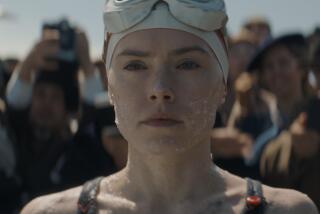Dolphins are feel-good story of the season
- Share via
CABO SAN LUCAS, MEXICO — Ronda Olds steps out of the pool, welling with emotion.
And who wouldn’t be after swimming with a dolphin that nudges you, kisses you and even dances across the water with you?
“Honestly, I couldn’t help but be moved,” says the wife and mother of two, visiting from Kamloops, Canada. “Today’s my birthday and, emotionally, I just feel overwhelmed.”
And that was before she’d learned that her swimming partner, a Pacific bottlenose dolphin, was one of five reportedly caught by Japanese fishermen and originally earmarked for human consumption.
“We had to rescue them by buying them,” says Alex Garcia, a caretaker for Cabo Dolphins, the sprawling new complex on the western edge of the Cabo San Lucas marina.
Olds also had not known that some of the older dolphins in the vast outdoor pool were ensnared locally by different groups before it became illegal in Mexico to remove dolphins from the wild.
They also were rescued, from smaller dolphin centers, and before coming here were part of a therapy program for children with autism. They soothed the children with sonar and, of course, gentle nudges.
Now, there are 10 dolphins at this resort city’s newest and most popular attraction, working their magic on everyday tourists and seemingly making the most of a life within boundaries.
They clearly enjoy the company of one another and, apparently, that of the many people they meet each morning and afternoon.
“I kinda want one now,” confesses Madison Olds, 8, while drying off beside her mother. “They make me feel, like, a great joy in my heart.”
*
The Cabo Dolphins facility was built in 2005 by renowned architect Enrique Norten. Since opening last February, it has lured tourists young and old, rich and famous.
Andre Agassi and Steffi Graf were recent visitors. Eva Longoria and Tony Parker were here during the summer, and a gossip magazine reported that the basketball player was visibly jealous of the attention given the actress by her slick new friend.
But such jealousy is for naught. Although the dolphins are friendly, it’s most likely because of the tasty fish they’re given by trainers throughout the 30-minute programs, which cost $165 per tourist.
Indeed, these dolphins, like those in the wild, have their own social structure and issues, much like humans.
Frida, for example, has taken a serious liking to Renoir, and sometimes finds it hard to concentrate on her job. On a recent morning, she was introduced to six tourists and gave them the usual swim-by, letting them pet her back and belly.
But she kept peering over her shoulder and finally bolted for the other side of the pool, to be near her boyfriend.
The 4-year-old dolphin started behaving that way only recently, after the older dolphins, some in their 20s, had arrived and disrupted the hierarchy.
Frida had enjoyed alpha-female status and now, trainer Serena Evans says, “She gets very nervous when she doesn’t have her other [young] dolphins with her -- especially her boyfriend.”
Thankfully, Ende, another young female who with Frida was among those captured by Japanese fishermen, swam forth and saved the day by giving rides, pecking cheeks and dancing with swimmers as though in a grand ballroom.
She then rolled over and let them rub her belly as Evans talked about behavior and anatomy, and the harmful effects of pollution and certain fishing practices.
“I enjoyed the whole experience because it gives you insight as to what they’re like and how delicate they are,” said Lindsey Kohn, a visitor from Cleveland, who had swum with captive dolphins once before, at a small enclosure in the Caribbean.
“Here you have interaction, instead of just swimming back and forth with them a few times.”
*
Lillian Fleisher is crying, then smiling, then crying again. Being only 5, she isn’t sure what to make of her situation.
She can’t swim but is treading water, snug in a life vest, with a 350-pound mammal circling like a shark.
Dolphins can sense the slightest nervousness, and Frida, having apparently put Renoir briefly out of her mind, seems intent on assuring Lillian that she wants to be friends.
The child looks to her family and, one by one, they encourage her by example.
Emma Fleisher, 8, receives a ride on Frida’s back and tells her brother how much fun it is. Charlie Fleisher, 7, follows suit.
Mom Melissa receives a kiss on the lips and tells her curious daughter how special it was.
David, the dad, swims with Lillian to the deep end and Frida offers her dorsal fin, but riding this mysterious beast is out of the question.
Finally, though, trepidation is replaced by triumph. A broad smile sweeps across the child’s face as she is greeted by the determined dolphin, grabs hold of her pectoral fins and goes dancing across the pool like the belle of the ball.
If anyone is jealous now, it’s Renoir.
More to Read
Sign up for The Wild
We’ll help you find the best places to hike, bike and run, as well as the perfect silent spots for meditation and yoga.
You may occasionally receive promotional content from the Los Angeles Times.






